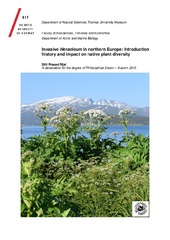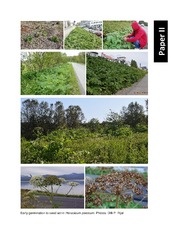| dc.contributor.advisor | Alsos, Inger G. | |
| dc.contributor.author | Rijal, Dilli Prasad | |
| dc.date.accessioned | 2016-04-07T09:38:12Z | |
| dc.date.available | 2016-04-07T09:38:12Z | |
| dc.date.issued | 2016-01-15 | |
| dc.description.abstract | Exotic invasive giant hogweeds are infamous in Europe for their ecological and economic damage; however, the magnitude of their impact on plant diversity has not yet been fully explored. In addition, uncertainties in their source and route of introduction impede management interventions. In such cases, molecular markers may bridge gaps between invasion history and management by providing insight into the complex history of biological invasions.
This thesis developed a microsatellite library for hogweeds, reconstructed the introduction history and evaluated the impact of H. persicum on Norwegian plant diversity. The microsatellite markers clearly discriminated the genetic structure of exotic invasive giant hogweeds, a native hogweed, and their invasive hybrids. Heracleum persicum was introduced twice from Iran to Denmark and England. English populations subsequently colonized Finland. In contrast to the contemporary hypothesis of an English origin of Norwegian populations, Finland appeared as a more likely source. The cover of H. persicum had a strong negative effect on the native cover. The invaded plots had on average nearly two native species less than the non-invaded plots. Plant communities containing H. persicum appeared less susceptible to further invasion. Overall, the impact of H. persicum on native plant diversity outweighs the invasion resistance it offers.
In conclusion, the strong negative impact of H. persicum on the Norwegian plant diversity justifies the need for the urgent management interventions to control and eradicate H. persicum. High invasiveness in Norwegian populations of H. persicum despite low levels of genetic diversity indicates that even a small founder population may cause high impact. The developed set of microsatellite markers may serve as an important genetic resource for understanding taxonomy, population genetics and phylogeny of giant hogweeds and their hybrids, which in turn, are expected to contribute to biodiversity conservation by invasive species management. | en_US |
| dc.description.doctoraltype | ph.d. | en_US |
| dc.description.popularabstract | Exotic invasive giant hogweeds are infamous in Europe for their ecological and economic damage; however, the magnitude of their impact on plant diversity has not yet been fully explored. In addition, uncertainties in their source and route of introduction impede management interventions. In such cases, molecular markers may bridge gaps between invasion history and management by providing insight into the complex history of biological invasions.
This thesis developed a microsatellite library for hogweeds, reconstructed the introduction history and evaluated the impact of H. persicum on Norwegian plant diversity. The microsatellite markers clearly discriminated the genetic structure of exotic invasive giant hogweeds, a native hogweed, and their invasive hybrids. Heracleum persicum was introduced twice from Iran to Denmark and England. English populations subsequently colonized Finland. In contrast to the contemporary hypothesis of an English origin of Norwegian populations, Finland appeared as a more likely source. The cover of H. persicum had a strong negative effect on the native cover. The invaded plots had on average nearly two native species less than the non-invaded plots. Plant communities containing H. persicum appeared less susceptible to further invasion. Overall, the impact of H. persicum on native plant diversity outweighs the invasion resistance it offers.
In conclusion, the strong negative impact of H. persicum on the Norwegian plant diversity justifies the need for the urgent management interventions to control and eradicate H. persicum. High invasiveness in Norwegian populations of H. persicum despite low levels of genetic diversity indicates that even a small founder population may cause high impact. The developed set of microsatellite markers may serve as an important genetic resource for understanding taxonomy, population genetics and phylogeny of giant hogweeds and their hybrids, which in turn, are expected to contribute to biodiversity conservation by invasive species management. | en_US |
| dc.description.sponsorship | This study was funded by Tromsø Museum, University of Tromsø - The Arctic University of Norway. | en_US |
| dc.description | Paper I and III of this thesis are not available in Munin.<br>Paper I. Rijal, D.P., Falahati-Anbaran, M., Alm, T. & Alsos, I.G. (2015) Microsatellite markers for Heracleum persicum (apiaceae) and allied taxa: Application of next-generation
sequencing to develop genetic resources for invasive species management. Available in <a href=http://dx.doi.org/10.1007/s11105-014-0841-y> Plant Molecular Biology Reporter (2015) 33:1381-1390</a><br>Paper III. Rijal, D.P., Alm, T., Nilsen, L. & Alsos, I.G. (2015) Giant invasive Heracleum persicum: Friend or foe of plant diversity? (Manuscript) | en_US |
| dc.identifier.isbn | 978-82-8266-109-6 | |
| dc.identifier.uri | https://hdl.handle.net/10037/9114 | |
| dc.identifier.urn | URN:NBN:no-uit_munin_8665 | |
| dc.language.iso | eng | en_US |
| dc.publisher | UiT The Arctic University of Norway | en_US |
| dc.publisher | UiT Norges arktiske universitet | en_US |
| dc.rights.accessRights | openAccess | |
| dc.rights.holder | Copyright 2016 The Author(s) | |
| dc.subject.courseID | DOKTOR-002 | en_US |
| dc.subject | Population genetics and vegetation ecology | en_US |
| dc.subject | VDP::Matematikk og Naturvitenskap: 400::Zoologiske og botaniske fag: 480 | en_US |
| dc.subject | VDP::Mathematics and natural science: 400::Zoology and botany: 480 | en_US |
| dc.title | Invasive Heracleum in northern Europe: Introduction history and impact on native plant diversity | en_US |
| dc.type | Doctoral thesis | en_US |
| dc.type | Doktorgradsavhandling | en_US |


 English
English norsk
norsk
